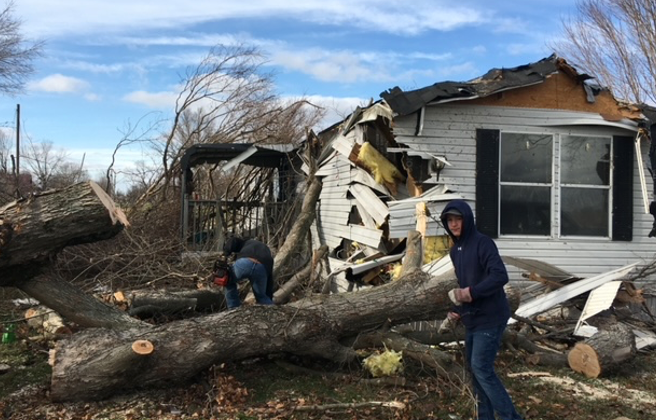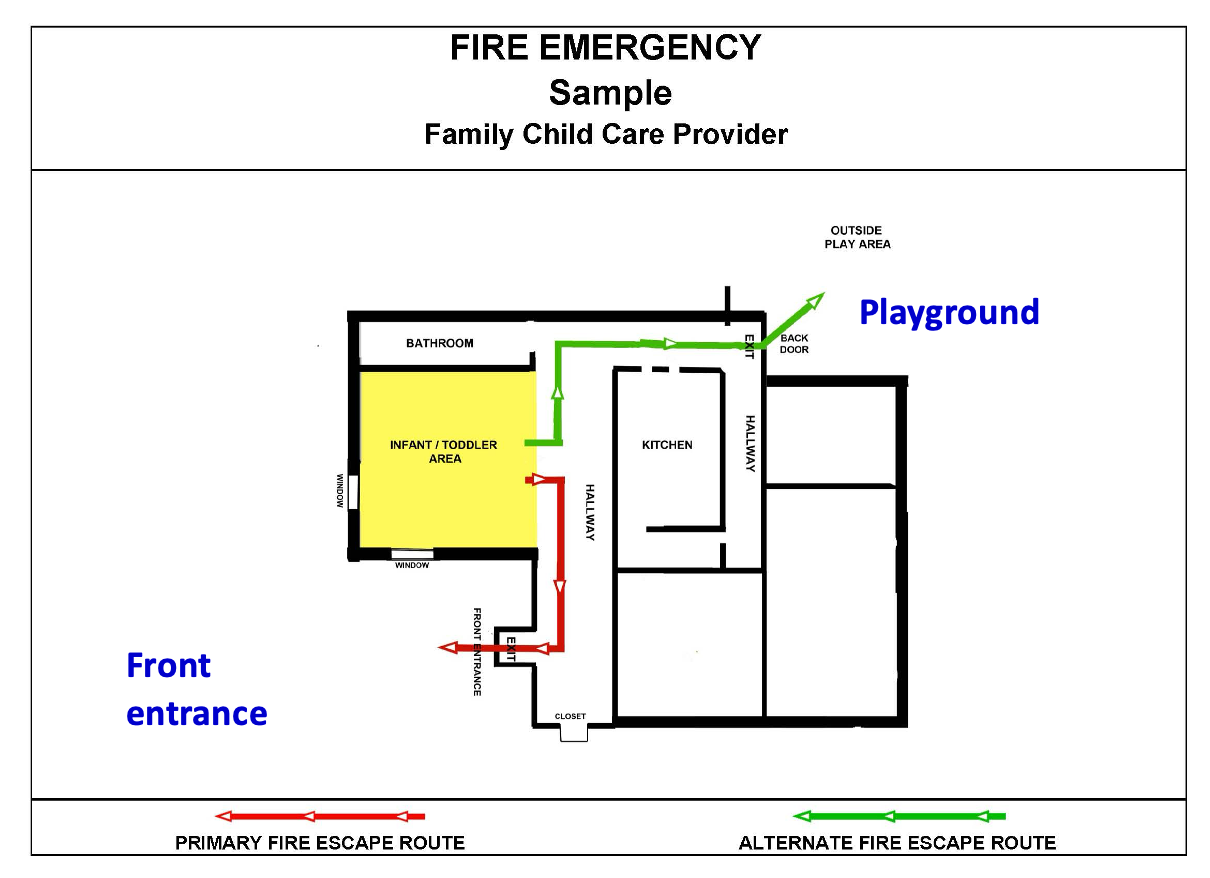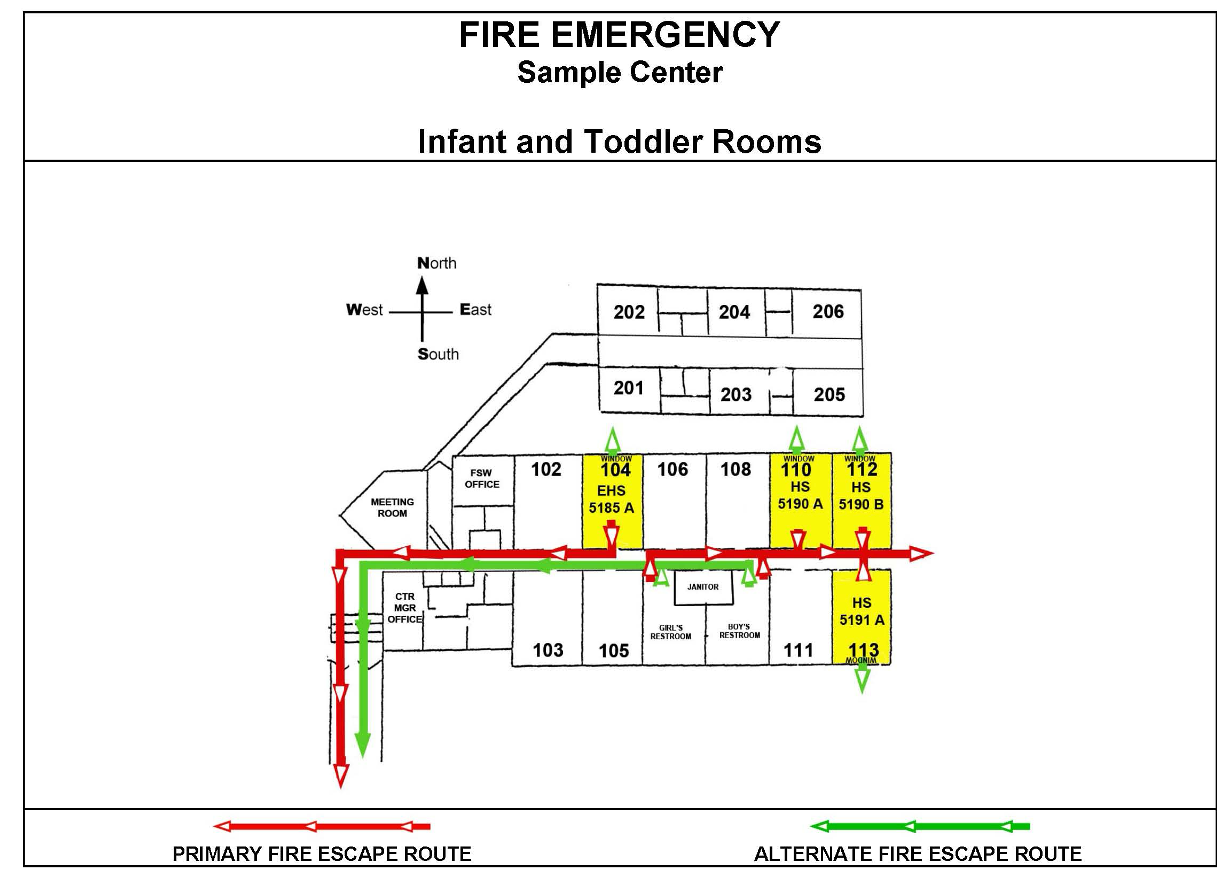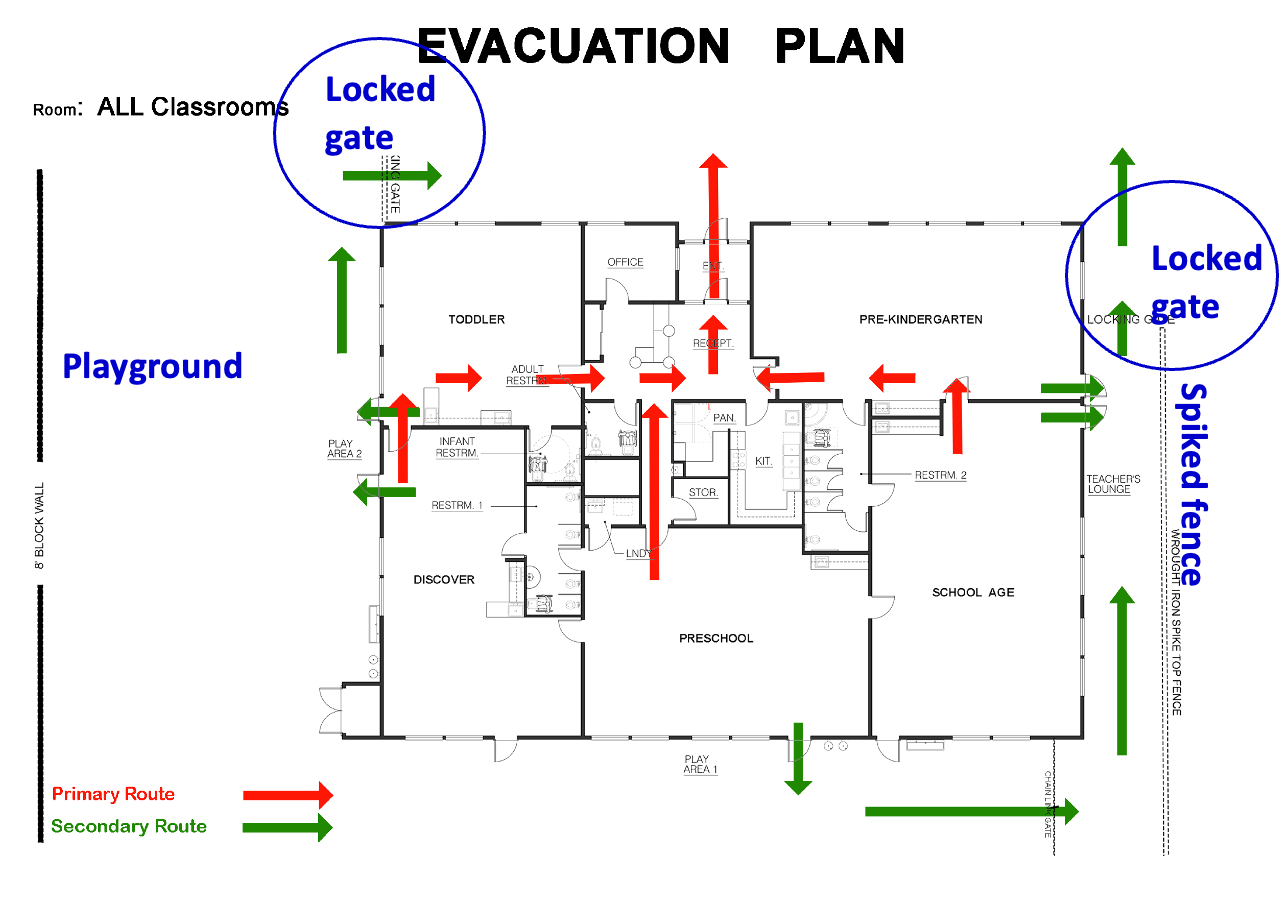Editor’s note: This text-based course is an edited transcript of the webinar, Evacuation in ECE Settings: Everyone Out!, presented by Charlotte M. Hendricks, PhD.
Learning Outcomes
After this course, participants will be able to:
- Specify disaster situations that could require evacuation.
- Describe steps to safely and rapidly evacuate children in various settings and situations.
- Identify the preparation and supplies needed based on children’s ages, special needs, or other factors.
Outline
- Explore situations in which evacuation is necessary.
- List preparation steps for all types of evacuation.
- Detail emergency evacuation response.
- Detail prepared evacuation response.
- Describe the next steps, including contact with families.
First, we will explore some situations, in which evacuation is necessary. Then, list some preparation steps for all types of evacuation. As we go through here, you'll see that there are different types of evacuation, but they still follow many of the same steps. Next, we'll detail some emergency evacuation responses, some prepared evacuation responses, and the next steps after evacuation, including contact with families.
Definitions
Disaster/Emergency
Disasters, also known as emergencies, encompass occurrences that result in property damage, injuries, or fatalities within a community. While the term "disaster" may evoke images of hurricanes or forest fires, it is essential to recognize that it can range from a nursery smoke detector triggering an evacuation to more conventional events like a fire in the kitchen trash can. Disasters, by definition, have low probabilities of happening but carry high consequences, emphasizing the need for preparedness without inducing panic.
The spectrum of disasters spans various categories. Facility-related events, including fire drills and preparations for gas leaks, are routine aspects. Natural disasters like tornadoes, hurricanes, winter storms, flooding, and earthquakes are geographical considerations. Technological events, such as blackouts, transportation breakdowns, and water loss, can disrupt childcare services. Additionally, intentional disasters like explosions, bioterrorism, threats of violence, or active shooter situations are unfortunate but critical aspects of preparedness.
Reflecting on my elementary school days, when fire drills were a norm, it is evident that disaster preparedness extends beyond specific geographical locations and embraces a wide range of potential events. The key is approaching preparedness with a measured mindset, acknowledging the low probability while recognizing the importance of being ready to mitigate potentially severe consequences.
First Responder
In disaster preparedness, it's essential to grasp the significance of first responders. These individuals, including firefighters, law enforcement, paramedics, and other professionals, play a vital role by offering immediate assistance during a disaster. They are the ones who guide decisions on whether to shelter in place or evacuate, depending on the nature and severity of the situation.
Understanding the instructions provided by first responders is crucial, as different disasters may require distinct responses. For instance, in an earthquake, initial guidance might be to "get down and cover your head" for shelter, but after the earthquake, the directive could shift to "get out" due to potential hazards within the building. Building a connection with first responders is encouraged, even if not on a first-name basis. Establishing communication procedures with them beforehand ensures smoother coordination when their expertise is needed.
Resource
I'd like to highlight a valuable resource titled Disaster Planning and Preparedness in Early Childhood and School-Aged Care Settings, which I co-authored with Michelle Pettibone. This resource is available at Redleaf Press and Amazon. Interestingly, I recently discovered that you can also purchase pre-owned copies at Walmart, offering a cost-effective option.
Types of Evacuation
Evacuation means getting everyone out of the facility or off the premises. Figure 1 was taken about 200 feet from where I live.

Figure 1. An example of an emergency near the author's home.
My neighbors were still in this shelter 10 minutes before the tornado hit, even though we had multiple warnings. They did get out at the last minute, which is very fortunate because the tree fell on the girl's bedroom.
Immediate Evacuation
Immediate evacuation, often associated with scenarios like a fire alarm, implies the urgent need to exit promptly. This could be prompted by a fire, gas leak, carbon monoxide release, explosion, or a chemical spill within the facility. Even seemingly minor incidents, such as the breakage of an old glass thermometer containing mercury, warrant immediate evacuation, emphasizing the varied nature of each situation.
In the context of a fire, for instance, occupants may have as little as two minutes from the sounding of the warning to safely evacuate. Contrary to common misconceptions, the process isn't as simple as grabbing personal belongings and swiftly exiting. For instance, in a scenario where a fire begins in a trash can near curtains, it takes approximately two minutes for the fire and smoke to accumulate sufficiently to trigger the smoke detector. Following this, there is an additional two-minute window before the situation can escalate to a point where the building is fully engulfed, making evacuation impossible. This underscores the critical importance of understanding the specific dynamics of each emergency.
Planned Evacuation
Another type of evacuation is what I refer to as a planned evacuation. This term encompasses situations where advance notice is available, often associated with weather-related issues, such as snow or ice, in regions unaccustomed to handling such conditions. In the South, where driving in snowy or icy conditions is challenging, institutions may opt for a planned evacuation by releasing students early to ensure their safe return home before road conditions worsen.
Unlike immediate evacuations requiring swift action within a short timeframe, planned evacuations allow for a more organized approach. Schools, for instance, can dismiss students by class, notifying parents and providing ample time for children to gather their belongings. This method offers a controlled evacuation process, giving institutions the opportunity to assemble necessary supplies, communicate with families, and reassure them that the children will be taken care of until a safe reunion is possible.
Illustrating the importance of coordinated planning, an incident in Alabama highlighted the consequences of inconsistent approaches to planned evacuations during adverse weather. While some schools followed first responders' guidance, advising parents to stay put as the children were in safe hands, others insisted that parents must come to pick up their children. This resulted in chaotic scenes with parents navigating through snow-covered roads to reach schools, emphasizing the need for clear and well-coordinated evacuation procedures based on the nature of the situation. Take a moment to reflect on potential risks in your facility, considering scenarios that might necessitate evacuation.
Evacuation as the Second Response
Another evacuation scenario is what I refer to as a second response. In situations involving potential violence, such as an active shooter or a bomb threat, the initial response typically involves running, hiding, and fighting if necessary. In the case of an active shooter, the immediate instinct is to run and escape, followed by hiding if escape isn't feasible, and as a last resort, fighting back. However, circumstances might unfold in a way that necessitates a second response involving evacuation.
For instance, if there is a warning about an active shooter, or if the sound of gunfire is heard, the initial response could be to lock down and hide in designated areas. Yet, as the situation evolves, it might become apparent that running and evacuating the premises is a safer option. Similarly, with a bomb threat, the initial reaction could involve sheltering in place. If first responders confirm the threat's validity, an evacuation order may follow, potentially requiring different exit routes to avoid potential danger.
The concept of a second response is also applicable in scenarios like a gas leak in the community with a concern about an explosion. In such cases, authorities might advise staying in place until further instructions or transportation arrangements are made. This cautious approach prevents an immediate rush outside, especially if there's a risk of a gas explosion in the vicinity. As with any evacuation plan, clear communication with first responders and adherence to their instructions are critical to ensuring the safety of individuals in the facility.
Suspicious Object/Bomb Threat
I want to emphasize the importance of addressing a suspicious object or bomb threat, as these are scenarios that people may not typically prepare for but require a measured response. If someone notices an unattended package in the hallway or near an entrance that seems out of place or lacks proper identification, it's crucial not to panic but to take immediate action.
In such a situation, contact the receptionist, director, or the person in charge to inquire about the package. If there's uncertainty about its origin or contents, it's essential to call 911 promptly. This becomes especially significant in areas that have experienced previous incidents or threats. Authorities may advise evacuation as a precautionary measure.
When dealing with a suspicious object, prioritize using an exit route that avoids proximity to the object. Always be mindful of your established exit strategies, ensuring they avoid any potential danger. Importantly, refrain from using any electronic devices, such as cell phones, two-way radios, fire alarms, or light switches, as some explosive devices can be triggered remotely.
Maintain a heightened level of alertness during evacuation. Consider diverting to an alternative route if you notice something unusual along the exit path. Once outside, gather at the designated meeting place and conduct a headcount to ensure that all individuals, especially children, are accounted for. Reiterating the importance of this practice cannot be overstated—know the number of individuals present and their locations to facilitate a swift and accurate headcount.
Evacuation
- Warning system – identify the situation
- Exit routes – 2 ways out!
- Meeting place
- To-go supplies – for immediate needs
Think about your preparation for evacuation and ensure you have these four things in place. Evaluate the effectiveness of your warning system, encompassing fire alarms, tornado sirens, or any alerts specific to your facility. In a lockdown scenario, the warning may involve someone verbally declaring "Lockdown," signaling an imminent danger that requires immediate action. Key components of preparedness include having two exit routes, a designated meeting place, and readily accessible "to-go supplies" for swift evacuation. The term "to-go supplies" captures the essence of having essential items readily available for quick and efficient departure.
Evacuation: Warning System
An essential aspect often overlooked involves the immediate activation of the facility-wide alarm by the adult identifying a potential danger or threat. Whether it's a triggered smoke detector in the nursery or a kitchen fire observed by food service personnel, the individual witnessing the danger should initiate the alarm. This proactive approach is crucial, considering the limited time available—potentially less than two minutes—to evacuate during a fire.
Certain evacuations may be directed by first responders or emergency services, as illustrated by the example of staying in the school during a snowstorm. The person in charge, often the director or owner, is pivotal in communicating with first responders and relaying instructions to the staff. Identifying a clear chain of command ensures an organized response, preventing overload on emergency services, such as 911. Every facility should designate a responsible individual known to first responders as the primary contact.
It is paramount to heed instructions from first responders. If instructed to evacuate, follow their guidance promptly. In emergencies, their directives precede any conflicting instructions from internal personnel, emphasizing the importance of immediate and coordinated responses based on professional guidance.
Evacuation: Exit Routes/Two Ways Out
Ensure every nursery and classroom in your facility has two designated exit routes. The primary exit should be closest to the exterior door, while the secondary exit might involve windows, different hallways, or varying levels within the building. Both primary and secondary routes should be practiced regularly to ensure readiness. In emergencies, assess the primary exit for potential obstacles, such as smoke, fire, debris, or any suspicious activity, and be prepared to use the secondary route if necessary.
Display maps of primary and secondary exit routes in each room and hallway, emphasizing clarity and visibility. Examples can be seen in Figures 2 and 3.

Figure 2. Fire emergency sample for a family child care provider (Click here to enlarge the image).

Figure 3. Fire emergency sample for infant and toddler rooms (Click here to enlarge the image).
Hallways and exit routes must remain unobstructed at all times. Avoid storing items, like tricycles, in exit pathways to facilitate clear evacuation routes. Ensure that exit doors open easily from the inside, are well-marked, and equipped with emergency lighting. Additionally, mark doors that are not exits clearly, using universally recognized symbols like the "No Exit" sign with a circle and slash.
Consider the feasibility of windows as exit routes. Check if windows are large enough for adults and children to escape, and evaluate whether they can be quickly unlocked. Test for potential issues like painted shut windows and ensure that the drop to the ground from windows is reasonable. If applicable, practice dropping to the ground using playground equipment or other safe structures.
Evaluate and document exit routes specific to your program, noting primary and secondary paths. Display these evacuation routes prominently beside classroom doors for easy access, especially for new or substitute teachers, and encourage regular reviews to maintain preparedness.
Evacuation: Meeting Place
- On-Site Meeting Place
- Count heads. Compare to daily attendance.
- If a child was with a different teacher or aide, notify the primary teacher of the child’s safety.
- If a child or staff person is missing, inform first responders. Have a communication network to check with other staff.
- Return to the facility only when deemed safe by first responders.
Designating a safe meeting place on your property is vital for the safety of children and adults during evacuation scenarios. This designated area, whether a specific tree, building, or spot on the playground, should be consistently utilized during drills for familiarity. The safe meeting place serves several key purposes, such as ensuring the safety of children, reuniting groups in case of separation, and facilitating an efficient headcount.
Considerations for the safe meeting place include checking if it leads to a secure outside area, like a fenced playground, ensuring gates can be easily opened from the inside, evaluating its proximity to traffic routes, and collaborating with the fire marshal to choose the best location.
Figure 4 shows an evacuation program I did in California. As you can see, they had to go through and out the front door to get out from the primary route. However, a secondary route went straight out to the playground.

Figure 4. Example of an evacuation plan (Click here to enlarge the image).
The problem was a very tall fence around it with a locked gate, and the staff did not have keys. We could not toss the kids over the fence to the firefighters.
- Off-Site Meeting Place
- Obtain permission in advance; renew annually.
- How will children be transported?
- The site should have adequate facilities and supplies.
It's crucial to inform parents in advance when planning offsite meeting places, such as during evacuations to a different location. For instance, communicating that a nearby public library will be the designated meeting place. Clearly communicate this location for child pick-up, taking into account the security and safety of both children and parents.
Maintaining staff-child ratios, supervision, and following proper procedures, including asking for photo identification, are essential for ensuring the children's safety in your care during offsite evacuations. For example, always request photo identification, even from familiar faces like neighbors, to uphold security protocols.
We're now going to talk about how to actually get our children out of the facility quickly and safely.
Evacuating Children: Infants and Toddlers
For infants and toddlers, strategically placing evacuation cribs by the door is a highly effective approach. These cribs, compliant with CPSC standards, serve a dual purpose—they can be used for daily needs like nap time and seamlessly transition into evacuation tools during emergencies. With large wheels and brakes, these cribs are easily maneuverable and stable, ensuring the safety of the children.
In the event of an evacuation, placing the infants or toddlers in the evacuation cribs and covering them with a fire blanket or protective covering facilitates swift movement down the hall and out the door. It's essential to assess the accessibility of the exit route, ensuring that it doesn't involve navigating difficult terrain such as stairs, as evacuation cribs are not suitable for rolling downstairs.
This approach also applies when evacuating children with special needs, offering a practical and efficient solution. The key is integrating evacuation cribs seamlessly into daily routines, maximizing their functionality for regular care and emergencies.
Evacuating Children: Children with Special Needs
When dealing with children with special needs, encompassing a spectrum of conditions such as visual, hearing, mobility, physical, healthcare, or mental/emotional needs, thoughtful planning for evacuation is paramount. Evacuation cribs prove valuable in many situations, as do other specialized apparatuses like wheelchairs.
Considering each child's specific needs ensures that the evacuation plan is inclusive and effective. For instance, if a child with special needs relies on a wheelchair, the plan should address how to safely evacuate that child, considering the unique challenges and requirements associated with mobility devices.
Evacuating Children: Toddlers and Preschoolers
Handling toddlers and preschoolers during evacuations requires specific considerations due to their age and behavior. These young children might not consistently follow instructions even if they've been practicing. Counting heads and keeping them together are crucial steps.
Toddlers, especially, can be quite mobile, sometimes faster than adults. However, relying on them to stay close or follow directions during an evacuation may not be realistic. Visibility concerns can arise, particularly in situations involving fire or smoke. If the environment becomes chaotic with crying and screaming, or if first responders use sirens, the children may not hear instructions.
Young children might respond to danger by hiding, freezing, or running in the wrong direction. To address these challenges, a practical solution is essential. Implementing strategies to manage and guide toddlers and preschoolers during evacuations is a commendable aspect of ensuring their safety in emergencies.
Grab and Go Evacuation Rope
I helped develop the Grab and Go Evacuation Rope, which is available at HopscotchSchoolSupply.com and Amazon. It addresses the challenge of keeping children together during evacuations. The idea stemmed from observing people walking with children holding onto a rope, but the potential issue arose when children let go, got scared, or lost track of the group. Collaborating with Hopscotch School Supply in Scotland, the evacuation rope was developed, featuring a wide design, reflective strip, and handhold. It allows for attaching multiple ropes together, creating a secure line for guiding children during evacuations.
The rope includes loops with Velcro, allowing children to slip their hands through and secure them with Velcro, preventing accidental slips. During pilot testing in Headstart programs, children showed enthusiasm for the evacuation rope, finding it engaging and enjoyable. In some cases, when children were less responsive to verbal instructions, implementing the evacuation rope effectively kept them together. The rope became a practical tool for guiding children to various locations, such as the playground or auditorium, ensuring their safety and garnering positive responses from both children and caregivers.
Children with Fearful Response
Consider the potential responses that children may have during emergencies. Some children might fear loud sounds, flashing lights, or darkness. In situations like power outages, it's crucial to have emergency lighting and carry flashlights. Phones often have built-in flashlights that can be used in such cases. Children's reactions may also be influenced by past traumatic experiences, such as encountering a tornado, which could make them fearful of thunder and lightning.
In certain cases, children exposed to domestic violence situations may develop distrust toward first responders. If a child has been taught to hide when the police are mentioned, they might react similarly when encountering first responders during a childcare emergency. Educating children about the role of first responders as helpers is essential. Inviting first responders to interact with the children can be beneficial in fostering positive perceptions and helping them understand that first responders are there to provide assistance and ensure their safety.
Supervise Children
During emergencies, the supervision of children is critical. While maintaining appropriate child-to-staff ratios according to licensing and accreditation standards, caregivers and adults are specifically responsible for the children under their direct care during the event.
For example, if two teachers are present and one briefly leaves the room to retrieve food from the kitchen while the children eat, this is acceptable as the child-to-staff ratio is maintained. However, if an adult is taking a child to speech therapy or the restroom and an emergency occurs, they are solely responsible for the safety and evacuation of those specific children.
In an evacuation, caregivers should focus on the children they are supervising. If, for instance, a teacher has taken two children to the restroom when the fire alarm sounds, they must evacuate those two children immediately. There is no need to return to the classroom to rejoin the class; instead, caregivers should proceed directly to the designated meeting place with the children they are responsible for.
Head Counts
Constant head counts are crucial before leaving the room, during evacuation, and at the meeting place. This head count should be compared to the daily roster.
Additionally, if a teacher is aware that a child is taking a nap or might be in a secluded area during an evacuation, they should check rooms and closets for any children who could be sleeping or hiding. If a child is found to be missing, it is essential to notify the person in charge immediately. This ensures effective communication with first responders and prevents unnecessary risks. The person in charge can coordinate the search for the missing child while maintaining communication and keeping everyone informed.
To-Go Supplies
- Daily attendance roster
- Current information and authorization for each child
- First aid supplies
- Essential medications
- Address, directions, and phone number for the designated off-site meeting place.
Consider the following essential items for quick and efficient emergency response.
Ensure quick access to the roster by placing it in a designated to-go pack or keeping it within reach. Opt for a backpack or a smaller, convenient bag for easy concentration on the children. Secure information and authorization documents to comply with privacy regulations. Keep these documents in the to-go bag rather than visibly hanging on walls or easily accessible to visitors. Pack essential first aid items, including bandages, gloves, masks, and hand sanitizer. Focus on the basics to address immediate needs. Include medications like EpiPens for children or staff members with specific medical requirements. Ensure medications are part of the to-go supplies, either already in the backpack or readily available to be added during an emergency. Have clear information about the offsite meeting place for evacuation. Write down the address, directions, and phone number for effective communication with parents during emergencies. Finally, determine responsibilities for gathering these supplies, whether individual teachers manage their own or a designated person, such as someone at the front office, is assigned this role. Adapt your approach based on what works best for your program.
Teach Children How to Respond
Furthermore, teach children to respond effectively by practicing both exit routes. While official fire drills in public school systems may dictate specific routes, conduct your own practice exits for additional training. Identify any issues during these practices and make necessary adjustments promptly to ensure a clear and efficient evacuation.
Components of evacuation can be incorporated into play activities. For instance, use tools like the grab-and-go evacuation rope during walks or outdoor explorations. In a fire emergency, emphasize the "Get low and go" principle, teaching children to stay low to avoid smoke and toxic fumes. Adults should demonstrate bending over while guiding children with the grab-and-go evacuation rope.
Create engaging scenarios such as hanging a sheet or rope about three feet high in a hallway for children to practice exiting under the barrier. Introduce obstacles like a box or chair in exit routes to encourage children to adapt and find alternative paths. Promptly address any challenges encountered during these activities to reinforce the importance of multiple evacuation routes.
Encourage children to quickly line up and attach wrist straps to the grab-and-go evacuation rope. Ensure the placement of straps accommodates varying heights to avoid difficulties in holding onto the rope. Children can easily identify their assigned straps, fostering a smooth and organized evacuation process.
Partner with First Responders
Additionally, build familiarity and trust with first responders by inviting them to visit, meet the children, and interact with staff and family members. This initiative helps alleviate fears some children may have due to past domestic issues. Familiarity with first responders can also empower children to seek help in public spaces if they become separated from their caregivers.
During these visits, have first responders showcase their equipment and gear in front of the children to demystify their appearance. For example, firefighters can introduce themselves without the full gear and later put on the breathing apparatus, tanks, and helmets. This transparency helps children recognize their community helpers even in intimidating situations, fostering a sense of safety and cooperation.
Resources and References
Again, my book, Disaster Planning and Preparedness, prioritizes practical guidance over elaborate explanations. The user-friendly format allows quick reference to specific scenarios, such as active shooter situations or environmental contamination, with space for personalization. This dynamic approach enables childcare providers to maintain an adaptable disaster plan tailored to their needs.
Medical Emergencies in Early Childhood by Redleaf follows a similar structure, offering concise instructions for various scenarios, such as dealing with burns. It is a valuable addition to the to-go bag, providing immediate guidance on responding to medical emergencies without unnecessary details.
References like "Caring for Our Children" from nrckids.org and the "Emergency Preparedness Manual for Early Childhood Programs" (Headstart) can help to establish comprehensive health and safety guidelines. "Caring for Our Children" encompasses various health and safety protocols, providing a comprehensive resource for early care and education programs. The "Emergency Preparedness Manual" aligns with your disaster planning ideas, making it a practical tool for enhancing preparedness in childcare settings.
Lastly, use signs with universally recognized symbols, such as "Exit" and the circle with a slash indicating "No exit" for effective evacuation procedures.
Citation
Hendricks, C. (2023). Evacuation in ECE settings: Everyone out! Continued.com - Early Childhood Education, Article 23847. Available at www.continued.com/early-childhood-education
